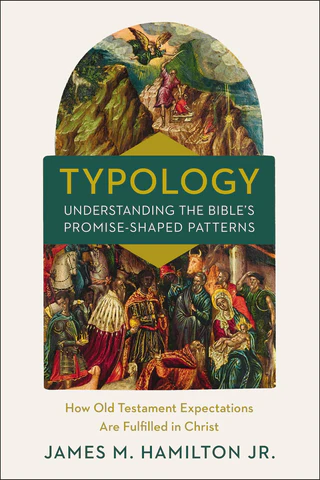
James M. Hamilton Jr.
Reviewed by: Andrew J. Miller
Typology—Understanding the Bible’s Promise-Shaped Patterns, by James M. Hamilton Jr. Zondervan, 2022. Hardcover, 432 pages, $29.49 (Amazon). Reviewed by OP pastor Andrew J. Miller.
Every Christmas Eve, our church holds a Lessons and Carols celebration where we alternate between singing hymns of Christ’s incarnation and hearing Scripture readings. The major emphasis of the biblical passages is promise and fulfillment—God promised a Savior, a snake-Crusher, and fulfilled his promise in Jesus’s coming. Our faith is strengthened by seeing such patterns—our confessional standards say as much: “the consent of all the parts” of Holy Scripture is one of the “arguments whereby it doth abundantly evidence itself to be the Word of God” (WCF 1.5).
Therefore, we should be thankful for James Hamilton’s Typology, which helpfully outlines major patterns of promise and fulfillment in God’s Word. Hamilton, a Baptist seminary professor, digs into biblical texts and connects the dots between, for example, Joseph and Jesus (217). Like Joseph, Jesus’s Hebrew brothers plotted to kill him, but God providentially used a suffering servant to bring salvation from death.
While advanced readers with knowledge of Hebrew will harvest most from this work, Hamilton’s writing style is inviting, and any Christian can profit from his presentation of how God progressively revealed more and more of himself and his plans over time. Because this work is saturated with God’s Word, it makes fine devotional material—I found reading it very enjoyable.
Hamilton rightly explains that “typology deals in repetitions” (28). In other words, biblical authors like Moses noticed that God dealt with his people in patterns and so presented future hope in terms of those same types (256). For instance, “Adam, Abraham, and Jacob all experienced exile from God’s presence in anticipation of salvation and return” (258). Their stories pointed to the exodus, which in turn pointed ahead to a new, heavenly exodus enacted by the Savior, proclaimed by Isaiah and Hebrews, among others.
Part 1 covers correspondences between biblical persons, showing how Christ is the second Adam, and our prophet, priest, and king, as well as the righteous sufferer. Part 2 covers paralleling salvation events, charting how God’s Word progressively unfolds the themes of new creation, new exodus, holiness in God, and the church as the bride of Christ. Genesis, Exodus, Leviticus, and Revelation feature heavily in Typology, and I plan to return to it when working through those books.
As with all books, readers will have to filter out less helpful content. Hamilton’s heavy use of the Old Testament literary device of chiasm to structure his own content is confusing and unnecessary (e.g., 332). Likewise, only scholars will be able to evaluate if Hamilton successfully refutes a new type of exegesis called “prosopological exegesis” (e.g., 195). Most importantly, I have my doubts that Hamilton gives sufficient attention to God as the divine author of Scripture. Again and again, he emphasizes only the human authors of the Bible and what they intended (e.g., 18, cf. 73).
Nevertheless, for most readers, the deeper hermeneutical debates Hamilton engages will fade into the background, as Typology pleasantly swims through the Scriptures, rejoicing in God’s promises, which are all “yes” in Christ (2 Cor. 1:20). Of Jesus, Hamilton writes: “Behold how great this man is: archetype and fulfiller of the patterns, Israel’s long history builds to him” (146).
July 13, 2025
Proclaiming Christ in a Pluralistic Age
July 06, 2025
June 29, 2025
June 22, 2025
June 15, 2025
June 08, 2025
June 01, 2025
© 2025 The Orthodox Presbyterian Church